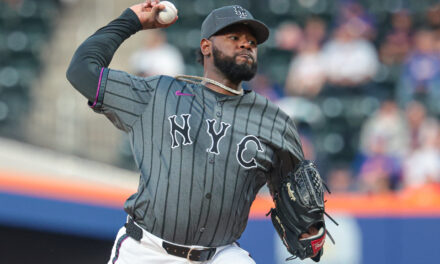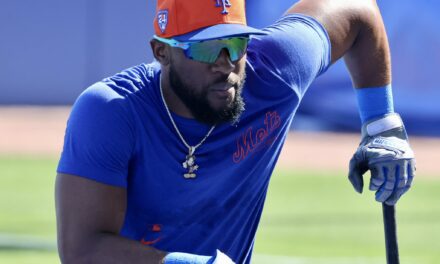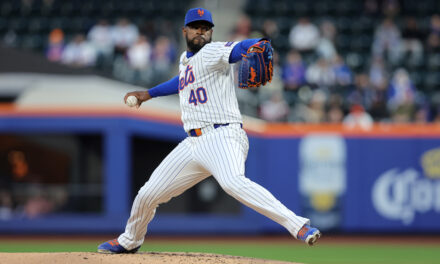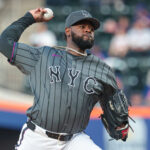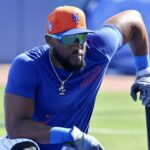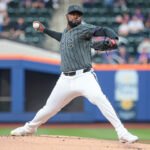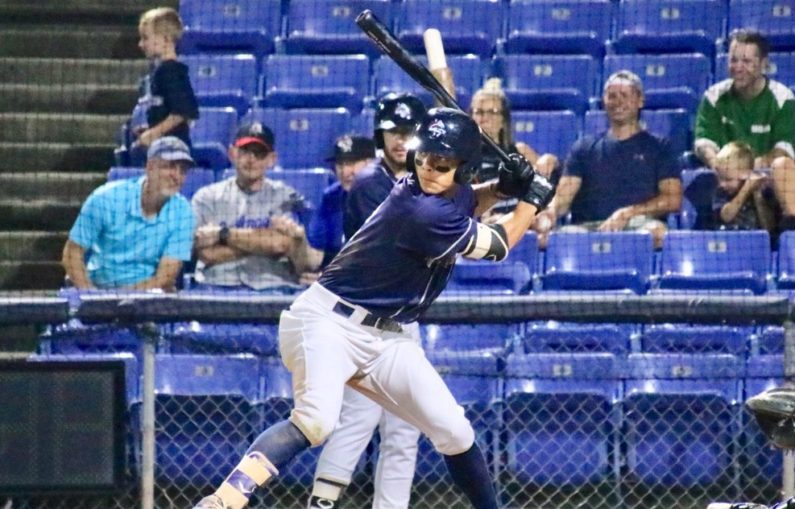
Photo by Logan Barer, MMO
Coincidentally, falling in line with the speculation around potential prospects the Mets would be willing to part with in a possible blockbuster deal with the Seattle Mariners, Baseball America recently updated its Top 10 Mets prospects ahead of the 2019 season. (We now know that Kelenic and Dunn are in the trade). The list reads as follows:
- Andres Gimenez, SS
- Peter Alonso, 1B
- Ronny Mauricio, SS
- Jarred Kelenic, OF
- Justin Dunn, RHP
- Mark Vientos, 3B
- Anthony Kay, LHP
- David Peterson, LHP
- Shervyen Newton, SS
- Simeon Woods-Richardson, RHP
Gimenez remains atop the list on the heels of a solid 2018 campaign between High-A St. Lucie and Double-A Binghamton. The 20-year old ranked as Baseball Prospectus’ 82nd-best prospect out of the top 100 coming into the year, and certainly padded his credibility with a .281/.347/.409 line over 122 games while being selected to play in the Futures Game in Washington during the All-Star break. He more than doubled a personal best with 38 stolen bases and held up a .971 fielding percentage at short, keeping true to his defense rating of 60 on the standard 20-80 scouting scale.
Baseball America points to Gimenez’s success as a result of, among other things, a “discerning batting eye [that] will keep his walk rate and on-base percentage high,” while heralding him as a “plus defender at shortstop with a plus, accurate arm,” and forecasting a “ceiling of first-division shortstop.” He has yet to relinquish the top spot since Amed Rosario was first promoted in late 2017, though an inevitable transition to second base (should he remain in the organization) as he progresses will be a major deciding factor as the Mets look for a way to get him to Triple-A Syracuse (at lowest) by the end of next year.
Peter Alonso needs little introduction behind his 36 home runs and 119 RBI between Binghamton, Triple-A Las Vegas, and the Arizona Fall League’s Scottsdale Scorpions. His slash line of .285/.395/.579 marked an improvement over an already impressive .289/.359/.524 mark the year prior, and he has slowly emerged as one of the most promising power hitters in the minor leagues. Many fans may remember his 113.6 mph home run at the Futures Game in July that set a Statcast era record not even a major leaguer has been able to reach.
Ultimately, Alonso’s most notable hangup comes on the other side of the ball, where he committed nine errors at first base – though admittedly split between six and three as the year went on despite receiving 70 more chances with Las Vegas. As he looks to further improve his footwork, the 23-year old should almost certainly receive big-league playing time in 2019. The question for Alonso is merely when the Mets decide they trust him enough to give him regular reps.
Making the biggest leap from the seven-spot in the middle of the year, Ronny Mauricio has made a lasting impression of his own as a young shortstop the Mets definitely value long-term. Baseball America cites Mauricio as a possible successor to Gimenez in “a year or two,” and given both his 70-grade arm and marked physical growth since the organization first signed him last year, there’s a lot to like.
The 17-year old entered August with a blistering .323/.333/.521 line with the Mets’ Rookie-Ball affiliate along the Gulf Coast before he tailed off, finishing at .279/.307/.421, though just 31 strikeouts in nearly 200 at-bats (15.5% K-rate) is nothing to sleep on. Per Baseball America, “his hand speed and bat speed stand out on the Mets’ internal metrics, and his timing and barrel frequency are impressive.” While the scouting report sees his limber figure settling in nicely at third base, Mauricio has exclusively manned shortstop last year, where he committed 16 errors, but still read the ball well to offset questions about his range.
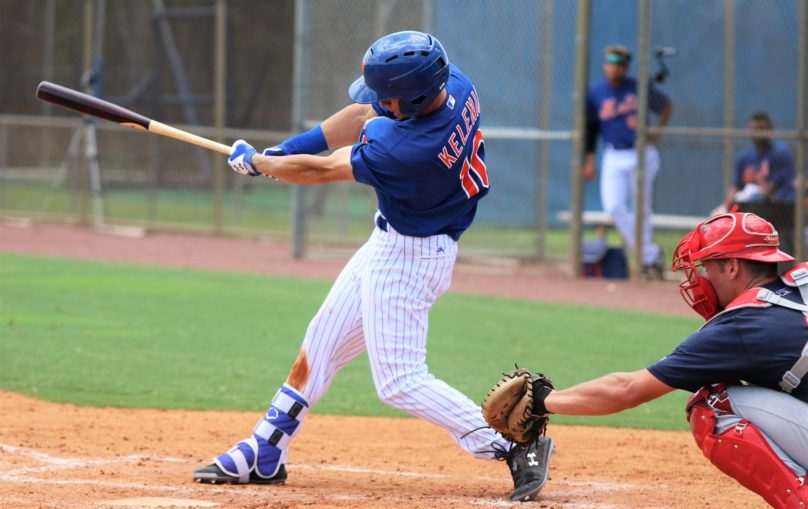
Jarred Kelenic/Photo by Ed Delany, MMO
Kelenic, a 19-year old taken with the sixth overall pick out of Waukesha High School in Wisconsin, impressed in a shortened first season with the Kingsport Mets (another Rookie-Ball club). After going .413/.451/.609 in 12 games a level down, Kelenic took a few steps back with a more modest .253/.350/.431 line, but still demonstrated proficiency handling each of the five tools. He swiped 15 bags in all, getting caught just once while recording nine assists in center field. A two-time world champion with the USA 18U National Team, his experience in wood-bat leagues and lauded baseball IQ have established a high ceiling that the Mets would be foolish to turn a blind eye to.
Dunn maintains his spot in the middle of the pack, but now enjoys the highest ranking of any pitching prospect in the Mets’ minor league system. Through 24 starts and 135.1 innings between High-A St. Lucie and Double-A Binghamton, he dazzled with a 3.59 ERA and 10.4 K/9, lowering his walk rate from 4.5 per nine innings the previous year to 3.5 in 2018. An increased use of the changeup and uptick in velocity both spoke for a more confident, comfortable pitcher in his first extended look as a starting pitcher. A 3.37 FIP in Binghamton and 40.5% groundball rate are both owed to an increase in first-pitch strikes that characterize Dunn’s potential as a three or four starter much more accurately.
In his second professional season with Rookie-Ball, Mark Vientos overcame a slow start (.230 average through his first 25 games), raking his way to a .287/.389/.489 mark with 11 homers and 52 RBI (both fourth in the Appalachian League) in 60 games. A shortstop through most of his high school career as well as his first year at the gulf, Vientos struggled to a .902 fielding percentage as he transitioned to third, but Baseball America is confident that his arm “fits the prototype.”
Shervyen Newton shares many of the same characteristics in terms of defensive profile and on-base capabilities, but is expected by many scouts to find more time either at third, second, or an outfield corner. The 19-year old Curaçaoan has been tabbed to have “potential 70-grade power down the line as his 6-foot-4 frame matures,” though his five homers in 56 games with Kingsport doesn’t say much, and whittling away at his 31.6% K-rate (nearly double that of Vientos) will likely be a priority as Newton continues to develop his swing.

Photo: Ed Delany, MMO
The seven and eight spots are each shared by similarly modeled lefties with strikingly different makeups. Kay, 23, struggled over 23 starts between Single-A Columbia and High-A St. Lucie, though not as the numbers may indicate. His K/BB ratio got squeezed to half-size upon moving up (3.55 to 1.67), though his 3.88 ERA in those ten starts fell much closer in line with his 3.61 FIP during the regular season. The first-round pick (31st overall) in 2016, Kay boasts a curveball that has peaked at 3,000 revolutions per minute (just over 100 lower than that of Seth Lugo between 2016 and 2017, for reference) as well as a fastball that tops out at 96 mph. For someone who sat out his first two professional seasons after undergoing Tommy John surgery, Kay has progressed well in his return, with Baseball America projecting a big-league ETA in 2020.
David Peterson, on the other hand, pitches to contact with an 89-91 mph fastball, feeding off swings and misses from a low-80’s slider while sporting a more pedestrian 8.1 K/9 this past year, albeit against microscopic walk and homer rates of 2.1 and 0.1, respectively. Peterson stumbled upon being promoted from Columbia to St. Lucie, as his season ERA rose from 1.82 to 3.16 while his WHIP increased from 0.914 to 1.172.
Also 23, Peterson dealt with both an ingrown toenail and tweaked knee through the year, but even then held together a groundball rate of 65% (third-best in the minors), accounting for his falling down a few pegs from his #4 spot on last summer’s list. Nonetheless, Peterson is quoted as having “ample starter traits” as well as “the best control in the system” to complement his current projection as a sturdy fourth starter.
Woods-Richardson, the last name on Baseball America’s current list and a name that didn’t even come up in last summer’s edition, impressed during his brief showing in the rookie leagues this past year. Woods-Richardson, who was the Mets’ second-round pick after Jarred Kelenic last year, struck out 26 while walking just four in 17.1 innings of work, topping out at 99 mph with his fastball while generally sitting in the low to mid-90s. He will be 19 next season, and could turn more heads if his “fiery, almost angry, mound demeanor and ‘now’ stuff” hold up well enough. Being able to contrast his heat with the sharp 12-6 curveball and elusive low-80’s changeup will be a necessity.


